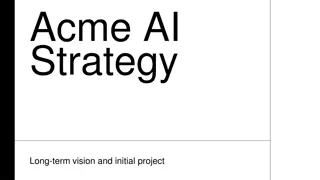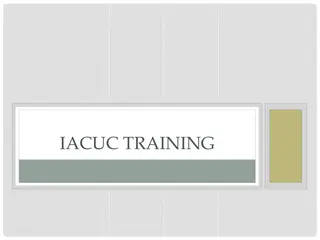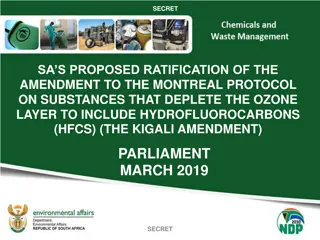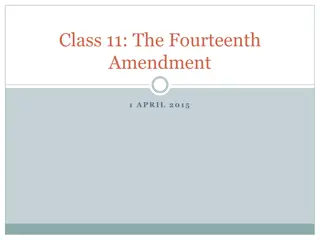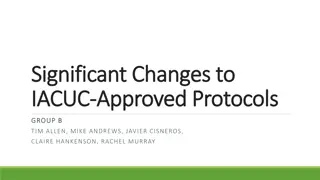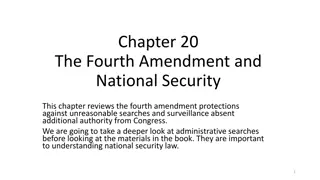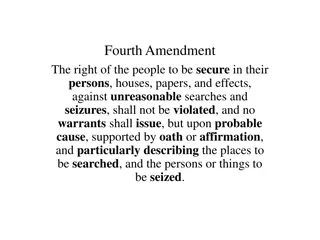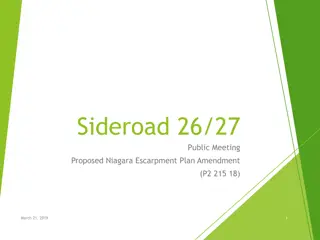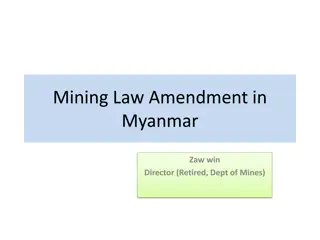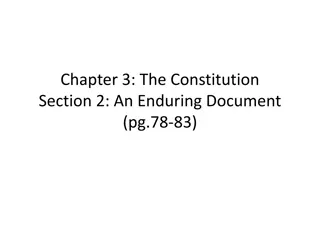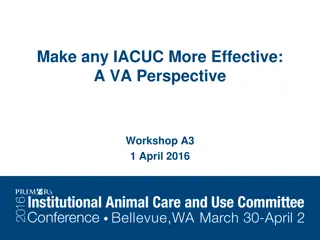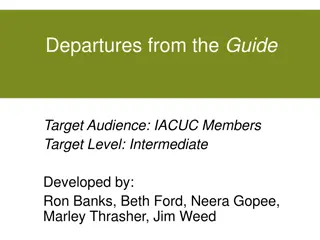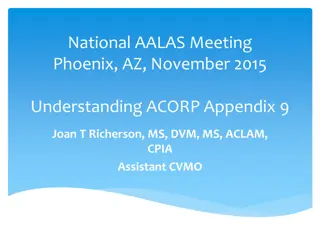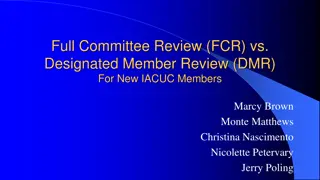Understanding ACME Looniversity's IACUC Amendment Policy
Delve into ACME Looniversity's protocol changes and amendment policy for IACUC protocols. Learn about significant vs. minor amendments, review processes, and criteria for administrative and designated member reviews. Explore the definition of significant changes and the proper methods of review to ensure compliance with institutional policies.
Download Presentation

Please find below an Image/Link to download the presentation.
The content on the website is provided AS IS for your information and personal use only. It may not be sold, licensed, or shared on other websites without obtaining consent from the author. Download presentation by click this link. If you encounter any issues during the download, it is possible that the publisher has removed the file from their server.
E N D
Presentation Transcript
Significant Protocol Changes at ACME LOONIVERSITY Anne Clancy, Jayson Egeler, Jean Kundert, Mary Travis May 2017 iCare TTI
Welcome new Principal Investigators!
Understand ACME Looniversity policy for review and approval of significant amendments to ensure compliance Goal Define a significant amendment based on our institutional policy Differentiate between examples of significant or minor protocol amendments Predict the proper method of IACUC review for significant amendments Objectives
Definition of Significant Change Changes that have, or have the potential to have, negative impact on animal welfare. In addition some activities that may not have a direct impact on animal welfare are also considered to be significant. OLAW Guidance (NOT-OD-14-126)
ACME LOONIVERSITY IACUC AMENDMENT POLICY Criteria & Process for Amendments to IACUC Protocols All amendments to IACUC Protocols must be reviewed by the IACUC before implementation. Amendments are reviewed through one of the following methods: Administrative Review Designated Member Review (DMR) Full Committee Review (FCR) Veterinary Verification and Consultation (VVC)
ACME LOONIVERSITY IACUC AMENDMENT POLICY ADMINISTRATIVE REVIEW (MINOR): Personnel changes (excluding PI) Reduction in the proposed number of animals Refinement in techniques to be less invasive One-time addition of up to 10% of the total animal numbers requested (mice and rats only) Change in strain of mouse Minor Changes- no impact on animal welfare that can be reviewed by the IACUC office staff only.
ACME LOONIVERSITY IACUC AMENDMENT POLICY DESIGNATED MEMBER REVIEW- DMR (SIGNIFICANT): Addition of >10% of the total animal numbers requested (mice and rats) Addition of animal numbers for USDA covered species Addition of noninvasive procedure Changes in husbandry (e.g., addition of a new diet) Change in PI Significant changes that can be reviewed by appropriately qualified IACUC members appointed to conduct the review.
ACME LOONIVERSITY IACUC AMENDMENT POLICY FULL COMMITTEE REVIEW-FCR (SIGNIFICANT): Changes in the objectives of the study A proposal to switch from a non-survival to survival surgery Increases in the degree of invasiveness of a procedure or discomfort to an animal Change in species Addition of a hazardous material that requires special handling of animals or bedding Withholding analgesia Significant changes reviewed by a convened quorum of the IACUC.
ACME LOONIVERSITY IACUC AMENDMENT POLICY VETERINARY VERIFICATION AND CONSULTATION-VVC (SIGNIFICANT)** Change in anesthesia, analgesia, sedation, or experimental substances Change in euthanasia to an AVMA-approved method Change in duration, frequency, type, or number of procedures performed on an animal Significant changes approved administratively with veterinary consultation per a new guidance from OLAW. The veterinarian acts as a subject matter expert to verify that changes requested meet the criteria in the IACUC policy. The veterinarian may refer any requests to IACUC review at any time for any reason.
Activity #1: Significant(S) vs. Minor(M) Polling #1 Add undergraduate student to personnel section M #2 Add 20 mice to a protocol that currently has 800 mice approved M #3 Add an IP injection of ketamine/xylazine as anesthesia for survival surgery S #4 Change human euthanasia to humane euthanasia in the euthanasia section of the protocol M #5 Add an additional experimental compound; no changes in procedure S #6 Adding osmotic pump implant to an existing project to replace IP injection S
Activity #2: Significant Change Review Methods Each group discuss the scenario on your handout (5 minutes): Identify the method of review as FCR, DMR, or VVC Justify your answer Report out (5 minutes).
#1 Significant Change Scenario Dr. Porky Pig has an IACUC approved project involving mice where 200ul of blood is collected monthly via saphenous vein collection. He recently hired the Tasmanian Devil as a new lab technician that is proficient in multiple bleeding techniques and has completed ACME IACUC required training. Dr. Pig requests that blood collection be increased to 200ul every 2 weeks using the mandibular vein collection method.
#2 Significant Change Scenario Dr. Wile E. Coyote is working with mice in a previously approved mouse adapted flu study. Currently, he is approved for CO2 euthanasia. This has been shown to negatively impact lung tissue samples. Dr. Coyote is requesting to change the euthanasia method to an IP injection of sodium pentobarbital.
#3 Significant Change Scenario Dr. Yosemite Sam has taken a new position at Flanders University in Adelaide Australia. His Post Doc Dr. Daffy Duck has remained at ACME to complete the current IACUC approved project. Dr. Sam requests the PI be changed to Dr. Duck.
#4 Significant Change Scenario Dr. Bugs Bunny has completed a pilot study using 100 mice. His preliminary data is very promising and supports moving forward with this infectious disease model. Analgesics have been shown to interfere with the clinical course of the disease and cannot be used. He requests an additional 2100 mice.
Understand ACME Looniversity policy for review and approval of significant amendments to ensure compliance Goal Objectives Define a significant amendment based on our institutional policy Differentiate between examples of significant or minor protocol amendments Predict the proper method of IACUC review for significant amendments
Summative Assessments 1/3 Select the appropriate definition(s) of a significant protocol amendment: a) a change that directly impacts the animals and the research b) a change to the protocol that substantially alters or affects the overall study objectives/rationale c) a change that impacts personnel safety d) a change in funding source
Summative Assessments 2/3 Classify the activities on this list as (S) Significant or (M) Minor protocol changes: ______changes from non-survival to survival procedures ______changes in study objectives ______changes in species ______add/change in Research Technician ______changes in Principal Investigator ______changes in housing location ______changes that impact personnel safety
Summative Assessments 3/3 Match the review method to the significant change per Institutional policy and justify your answer: A=FCR _______ Change in analgesic B=DMR _______ Adding a Category E procedure C=VVC _______ Change in PI
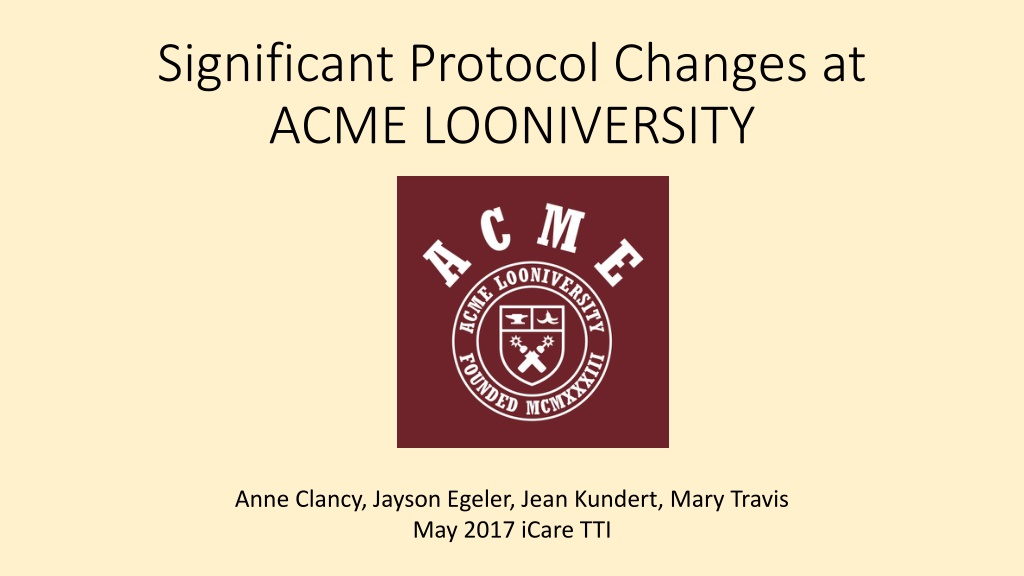

![RE: ELECTORAL MATTERS AMENDMENT BILL [ B42-2023]](/thumb/18837/re-electoral-matters-amendment-bill-b42-2023.jpg)
